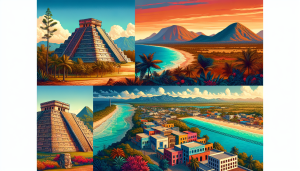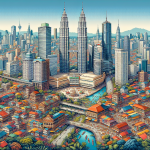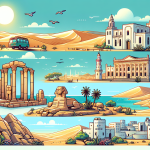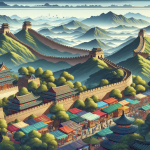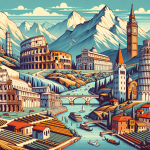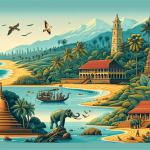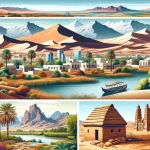Exploring the Wonders of Mexico: A Traveler’s Guide
Mexico, a land of rich culture, vibrant traditions, and breathtaking landscapes, has always been a favorite destination for travelers from around the globe. Located in the southern part of North America, Mexico is a treasure trove of ancient ruins, pristine beaches, bustling cities, and delectable cuisine. Whether you’re a history buff, an adventure seeker, or a food lover, Mexico offers something for everyone. In this comprehensive guide, we’ll delve into the myriad of experiences that await you in this remarkable country. From the ancient pyramids of Teotihuacan to the lively streets of Mexico City, from the tranquil beaches of Cancún to the vibrant markets of Oaxaca, we’ll cover everything you need to know to plan an unforgettable trip to Mexico. We’ll also provide practical tips on navigating the country, understanding the local culture, and savoring the authentic flavors of Mexican cuisine. So, pack your bags and get ready to explore the wonders of Mexico!
The Rich History of Mexico
Ancient Civilizations
Mexico’s history is deeply rooted in its ancient civilizations, which have left an indelible mark on the country’s cultural landscape. The Maya and Aztec civilizations are among the most well-known, but there are many others that have contributed to Mexico’s rich heritage.
- Maya Civilization: The Maya civilization flourished in southeastern Mexico, particularly in the Yucatán Peninsula. Visitors can explore the ruins of ancient cities like Chichen Itza and Tulum. Chichen Itza, a UNESCO World Heritage Site, is home to the iconic Pyramid of Kukulkan, an architectural marvel that attracts thousands of visitors each year.
- Aztec Empire: The Aztecs were dominant in central Mexico, with their capital city, Tenochtitlan, located where modern-day Mexico City stands. The Templo Mayor, an ancient Aztec temple, offers a glimpse into the grandeur of the Aztec civilization.
Colonial Influence
The arrival of the Spanish in the 16th century brought significant changes to Mexico. The colonial period left a lasting impact on the country’s architecture, religion, and culture.
- Mexico City: As the capital of New Spain, Mexico City became a hub of colonial architecture and culture. The historic center of Mexico City, known as Zócalo, is a UNESCO World Heritage Site and is home to the Metropolitan Cathedral and the National Palace.
- Puebla: Another city that showcases colonial architecture is Puebla. Known for its beautifully preserved colonial buildings and vibrant Talavera pottery, Puebla is a must-visit for history enthusiasts.
Natural Wonders of Mexico
Beaches
Mexico boasts some of the most stunning beaches in the world. Whether you’re looking for a relaxing getaway or an adventurous water sports experience, Mexico’s beaches have it all.
- Cancún: Famous for its white sandy beaches and crystal-clear waters, Cancún is a top destination for beach lovers. The Hotel Zone offers luxury resorts and a vibrant nightlife, while nearby Isla Mujeres provides a tranquil escape.
- Playa del Carmen: Located on the Riviera Maya, Playa del Carmen is known for its lively atmosphere and beautiful beaches. The nearby Cozumel Island is a popular spot for snorkeling and diving.
Mountains and Deserts
Beyond its beaches, Mexico’s diverse landscapes include majestic mountains and vast deserts.
- Copper Canyon: Located in the state of Chihuahua, Copper Canyon is a network of canyons larger and deeper than the Grand Canyon. It’s a paradise for hikers and nature enthusiasts.
- Sonoran Desert: Stretching across northwestern Mexico, the Sonoran Desert is home to unique flora and fauna. The town of San Carlos offers stunning desert landscapes and a chance to explore the Sea of Cortez.
Mexican Cuisine: A Culinary Journey
Traditional Dishes
Mexican cuisine is a delightful blend of indigenous and Spanish flavors. Each region of Mexico has its own unique dishes and culinary traditions.
- Tacos: No trip to Mexico is complete without trying tacos. From street vendors to upscale restaurants, tacos come in various forms and flavors. Don’t miss the chance to try tacos al pastor, a popular variation made with marinated pork.
- Mole: Originating from Oaxaca, mole is a rich, complex sauce made with a variety of ingredients including chili peppers, chocolate, and spices. Mole poblano, served with chicken, is a must-try dish.
Street Food
Mexican street food is a culinary adventure in itself. Exploring the local markets and street vendors will introduce you to a world of flavors.
- Elotes: Grilled corn on the cob, known as elotes, is a popular street food. It’s typically served with mayonnaise, cheese, chili powder, and lime.
- Tamales: Made from masa (corn dough) and filled with meats, cheeses, or vegetables, tamales are a traditional Mexican street food. They are steamed in corn husks and are a staple during festivals and celebrations.
Vibrant Festivals and Traditions
Day of the Dead
One of Mexico’s most famous traditions is the Day of the Dead (Día de los Muertos). Celebrated on November 1st and 2nd, this holiday honors deceased loved ones with colorful altars, marigold flowers, and sugar skulls. Towns like Oaxaca and Mexico City host elaborate parades and events that attract visitors from around the world.
Independence Day
Mexico’s Independence Day, celebrated on September 16th, marks the country’s independence from Spanish rule. Festivities include fireworks, music, and traditional dances. The main celebration takes place in Mexico City, where the President delivers the “Grito de Dolores” from the National Palace.
Practical Travel Tips
Getting Around
Mexico has a well-developed transportation network, making it easy to explore the country.
- Public Transportation: Cities like Mexico City and Guadalajara have efficient metro systems. Buses are a common mode of transportation for long-distance travel.
- Car Rentals: Renting a car is a convenient option for exploring remote areas and less accessible destinations. Ensure you have the necessary documentation and insurance.
Safety
While Mexico is generally a safe destination, it’s important to take common-sense precautions.
- Stay Informed: Keep up-to-date with travel advisories and local news.
- Avoid Risky Areas: Stick to well-traveled areas and avoid regions known for crime.
Savoring Mexican Culture
Music and Dance
Mexican music and dance are vibrant and diverse, reflecting the country’s rich cultural heritage.
- Mariachi: Originating from the state of Jalisco, mariachi music is an integral part of Mexican culture. Mariachi bands, dressed in traditional charro outfits, perform at festivals, weddings, and other celebrations.
- Folk Dances: Traditional folk dances, such as the Jarabe Tapatío (Mexican Hat Dance) and the Danza de los Viejitos (Dance of the Little Old Men), are performed during cultural events and festivals.
Art and Crafts
Mexico’s artistic traditions are showcased in its colorful crafts and artworks.
- Alebrijes: These whimsical, brightly colored sculptures of fantastical creatures are a hallmark of Mexican folk art. They are often made from wood or papier-mâché and are popular souvenirs.
- Talavera Pottery: Originating from Puebla, Talavera pottery is known for its intricate designs and vibrant colors. The pottery includes plates, tiles, and other decorative items.
Conclusion
Mexico is a land of contrasts and surprises, offering an endless array of experiences for travelers. From its ancient ruins and colonial cities to its stunning beaches and flavorful cuisine, Mexico captivates the hearts of all who visit. Whether you’re exploring the bustling streets of Mexico City, basking in the sun on the beaches of Cancún, or savoring the rich flavors of Mexican street food, you’ll find that Mexico is a country that leaves a lasting impression. As you plan your journey, remember to embrace the local culture, respect the traditions, and savor every moment of your adventure. So, what are you waiting for? Dive into the wonders of Mexico and create memories that will last a lifetime.
For more information on planning your trip to Mexico, visit Visit Mexico.
